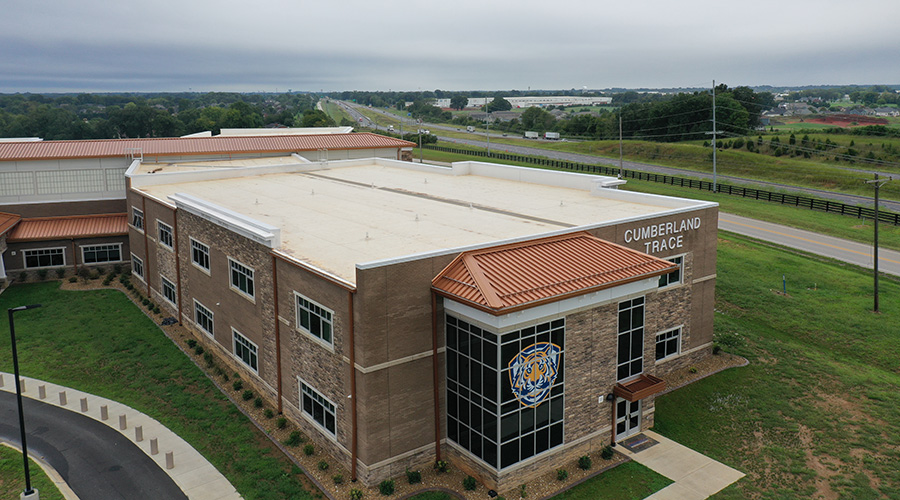Big plans on campus
Synchronizing strategic, master and capital planning is key to campus development
When most people think of a college campus, the picture that comes to mind is of stately buildings and tree-lined walkways. In fact, the image a campus projects can be a tremendous draw — or turnoff — to prospective faculty members and students.
Creating and sustaining a campus environment that reflects the goals and history of an institution of higher education requires comprehensive planning. While each school will have its own approach to the planning process, most produce three plans: strategic, master and capital plans. These are then translated into a budget.
It’s critical that the facilities management team understand and participate in the planning process, says Mark Purcell, senior associate specializing in higher education with Heery International. Facility executives can offer insight on proposed projects that others involved in the planning process probably can’t, and help ensure that any investments are made wisely.
The starting point is the strategic plan. Although no single definition of a strategic plan exists, it can be considered “the institutional long view,” says Persis Rickes, principal of Rickes Associates. “It’s not so much about space, but the mission, vision and goals of the institution.”
For example, the strategic planning committee may decide the university should build on the strength of its engineering program, while simply maintaining its foreign language department. Or a goal might be set to increase the proportion of students coming from outside the state. On a broader level, the committee may decide that the university should act as a responsible steward of the environment.
Many of the objectives outlined in the strategic plan affect the college’s land and buildings. This leads to the next step in the planning process, developing the master plan. “The university has its mission and values,” says Purcell. “The master plan’s job is to implement that and develop strategies to achieve the goals.”
For example, community colleges, more so than most four-year universities, need to respond quickly to changes in the broader business market, as well as trends in career paths, says John Watson, director of facilities service with North Lake Community College in Irving, Texas. For example, it’s not unusual for a corporate executive to ask a community college to develop a set of courses geared to the company’s business operations, and expect to have employees in the classroom six months later.
Because of this, North Lake purposely constructs facilities that are relatively generic. “We’re not going to build specific buildings for nurses, pharmacists, etc.,” Watson says. Instead, the college will build laboratories that can inexpensively be changed to meet future needs.
Land Use Planning
The leadership team at Emory University in Atlanta used the master planning process to determine how they wanted the university to look as it grew. In the process, they developed a detailed land use plan. “This is a guideline for the development of the campus,” says Bob Hascall, vice president of campus services. “It limits where you can build and the kinds of things you can build.”
Team members classified the approximately 700 acres of the campus into five categories, says Hascall. These are:
- Restricted: These 180 acres include land on which building is restricted by local and state regulations, for example, stream buffers and flood plains.
- Preserve land: This consists of about 160 acres of woodlands that the university will preserve as is.
- Conserve: This consists of 47 acres that “are valued for their unique cultural history, and contribution to the campus identity,” says Hascall.
- Managed Land: These 220 acres have some development, but are not completely built out. It’s possible to add development or re-develop the facilities already in place.
- Developable Land: This land, which totals about 100 acres, can be developed.
Within each category, the plan identifies neighborhoods of classroom buildings, residence facilities and office buildings. “This is the base for development for the future,” says Hascall. That way, leaders are less likely to place buildings in isolation, and are reminded to consider parking and walkways as they decide where to place buildings.
As part of the planning process, Hascall and his colleagues also developed a set of principles to ensure that future buildings are designed to use architectural themes of existing buildings.
Effective Master Plans
When it comes to the ideal time frame for updating or creating a new master plan, no firm guidelines exist. However, most facility experts say that between five to ten years is about right.
The planning committee also needs to decide how far into the future to look. The University of Wisconsin committee chose a time horizon of 20 years for space needs, and 30 years in planning for its utility requirements. That’s because most utility equipment lasts longer, and it needs to be sized to accommodate future growth, says John Harrod, director of physical plant.
The plan should be executed from both the bottom up and the top down. That is, faculty members present their ideas of what they need, while the administration and planning committee offer their visions for the university overall, and decide how best to allocate available funds. “If you have a good process, you’ll merge the two,” says Ray DuFrense, vice president of consulting services with VFA, Inc.
At the University of Wisconsin, for example, the chancellor established a steering committee composed of, among others, the campus planning committee, a transportation committee, a campus space management group, and representatives from the provost office. Representatives of the major academic units offered insight on projected growth.
Financial officers also should be included to let others know the potential price tags of projects under consideration. This is key, as it’s not unusual for some faculty members to ask for more than the university can provide. “When you talk with faculty about what they want to go into a building, they often have expansive ideas,” says Larry Bacher, higher education principal with Gilbane Building Company.
Similarly, facility executives also need to offer their insight. “They can ensure that the plans are grounded in fiscal reality,” Bacher says. It’s often easy for others to overlook the ancillary costs that accompany new construction, such as the expense of expanding the infrastructure.
By bringing all parties together, it’s less likely that potential obstacles or costs will be overlooked. Equally important is that a comprehensive and inclusive planning process sends a message to donors and other supporters that the university is responsibly using its resources, says Purcell.
Paying For It
The next step is developing the capital plan. “The master plan dictates concept and direction,” says Terry Ruprecht, campus academic facilities officer at the University of Illinois at Urbana-Champaign. “The capital plan discusses specific investment requirements and when they’ll take place.”
For example, if the master plan indicates that five new buildings are to be built over the next ten years, the capital plan will show the schedule in which these will be built, Hascall says.
That said, the capital plan should allow for flexibility. The order and types of projects may change, based on funding available. If a donor offers to cover the cost of a new building before funding for other projects is in place, it’s likely that the timeline for the donor’s project will be accelerated, says Bacher.
In addition, up to several years can elapse between the conception of a building and its construction. Other changes in the college or university can occur in that span of time that will influence construction projects and scheduling.
The capital plan typically provides a shorter-term outlook than the strategic or master plan. At the University of Wisconsin, for instance, the capital plan extends out for six years, or three biennial sessions, says Harrod.
Even so, the capital plan should be linked to the longer-term master plan. Rickes notes that attempting to prepare a capital plan in the absence of a master plan leads to tunnel vision. “You will just get projects that rise to the top and need attention,” she says. For instance, if a roof is leaking, the capital plan may include funds to fix it. However, in the absence of a master plan, it may not be evident that the building requires so much deferred maintenance that it makes more sense to raze it, rather than spend more to fix it. “Many times, I see campuses tear up a road three times, because they don’t look at utilities comprehensively,” Rickes says.
As part of the planning process, some universities create a database with detailed information on each building, says Purcell. This includes such information as the facility’s use, square footage and layout, a list of the building systems and their age, and projected maintenance needs. Some universities include any changes — some as small as a window that is broken and repaired — in the database.
By maintaining this information in one place, and in a format that can be readily accessed, it’s easier to evaluate proposals and identify needed maintenance and repair work. As a result, it is easier to combine like projects in order to address them more efficiently.
Similarly, some facility executives develop a separate infrastructure or utility plan. Then, as plans are made to erect new buildings, it’s easier to identify the systems that they’ll require. At some colleges, the plan also identifies “utility corridors,” such as streets and walkways, which are reserved for utilities. By highlighting these areas, the planning committee knows to refrain from building over them.

Following from the strategic, master and capital plans, the budget itemizes the projected costs of each phase of all the projects planned for the time period covered. Putting this information down on paper is critical, as “you can never construct the ideal building with the amount of money you have,” says Ted Weidner, assistant vice chancellor, facilities management and planning at the University of Nebraska, Lincoln. Almost all projects require some compromise. The key is to carefully identify all anticipated costs to avoid compromises that are likely to cost more down the road, Weidner says. For example, an inefficient heating and cooling system may cost less initially but will be more expensive to run.
Then, as projects get underway, the budget is a tool to check actual expenses against expected costs. This also helps ensure that the plans accurately reflect expected costs.
Preparing comprehensive plans and budgets and adhering to them requires discipline and a commitment of time and energy. However, the end result should be an attractive, welcoming campus and a school that is financially sound.
“Students make judgments about schools based on their facilities,” says Carol Wedge, president of Sheply, Bulfinch, Richardson & Abbott.
Studies show that poorly maintained facilities are one of the primary reasons prospective students decide not to attend a specific school. “The first impression is one of the biggest selling points for parents and students,” Watson says. Effective planning can help ensure that the facilities reflect positively on the institution.
EXISTING BUILDINGS
Funding Capital Renewal
Not surprisingly, the funding required to maintain existing buildings often takes a back seat to funding for new facilities. “New construction is exciting and compelling,” says Terry Ruprecht, campus academic facilities officer at the University of Illinois, Champaign-Urbana. “There’s a natural tendency for funds and attention to follow.” In addition, it’s not unusual for donors to the university to request that their contributions be allocated to specific — often new — construction projects.
“Replacing the HVAC system in a building is not something that many people are interested in putting their names on,” says Bob Hascall, vice president of campus services with Emory University in Atlanta. Even finding donors to fund a building renovation can be difficult, as it’s likely that the building already is named for a previous contributor.
One way to reduce this problem in the future is to ask what portion of any funding for new buildings is dedicated to operations, says Mark Purcell, senior associate specializing in higher education with Heery International. To be sure, this can be difficult to enforce, as it may mean that the building constructed is smaller or less upscale than what the donor planned.
In the meantime, however, the funding needed to maintain and update existing facilities typically has to come from within the institution itself, Hascall says. “You have to figure out some reasonable investment rate in capital renewal.”
That requires identifying for each facility one-time costs, annual recurring costs and periodic recurring investments. It’s this last category that typically catches people, says Ruprecht. People focus on the initial investment and annual maintenance costs, but overlook expenses that can be predicted, because they arise only periodically. That doesn’t need to be the case. “One can plan for these things,” Ruprecht says. “You don’t have to sit there for twenty years, then say ‘Oh no, we need air handlers.’”
|
Karen Kroll, a contributing editor for Building Operating Management, is a freelance writer who has written extensively about real estate and facility issues.
Related Topics:











